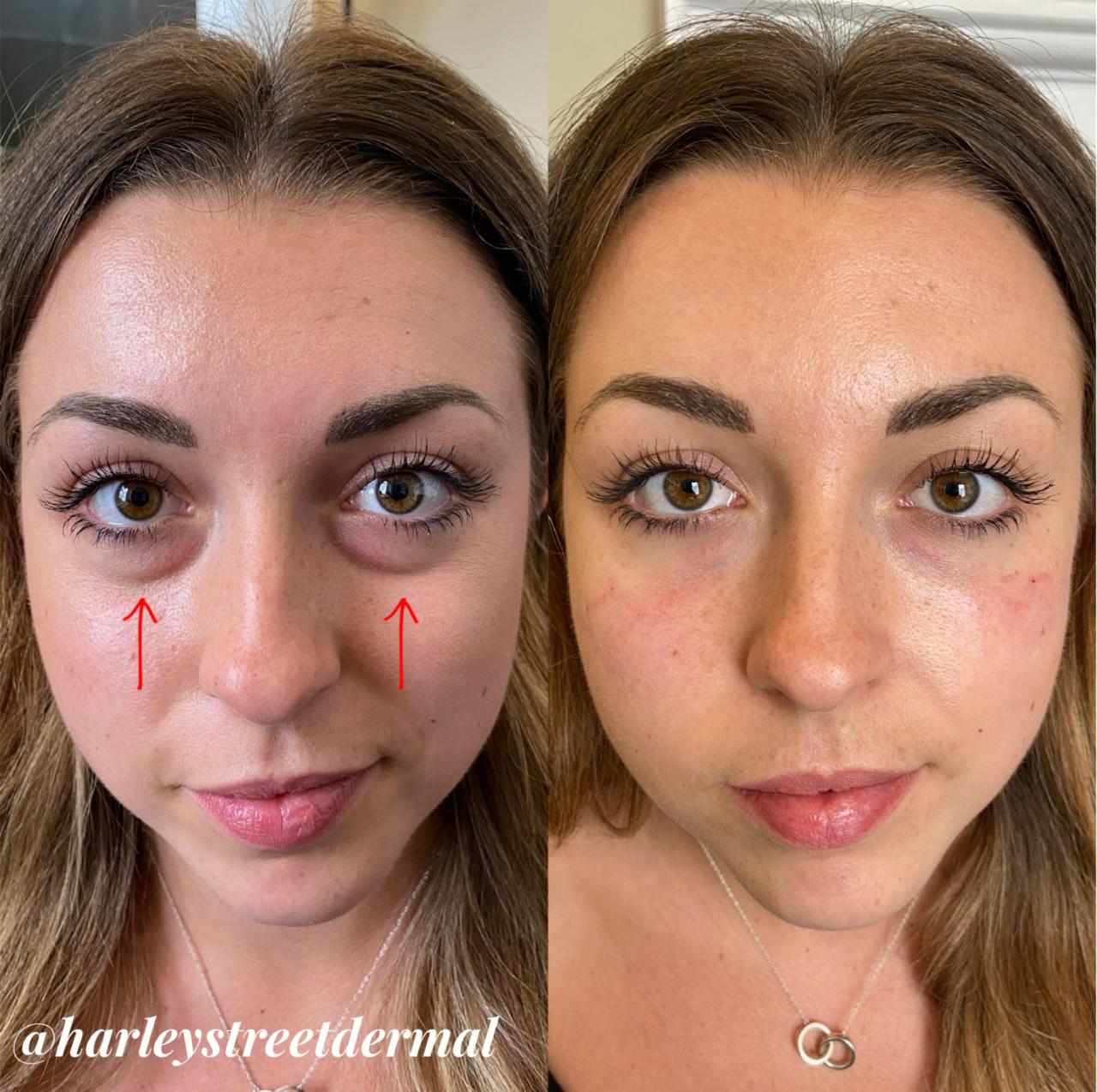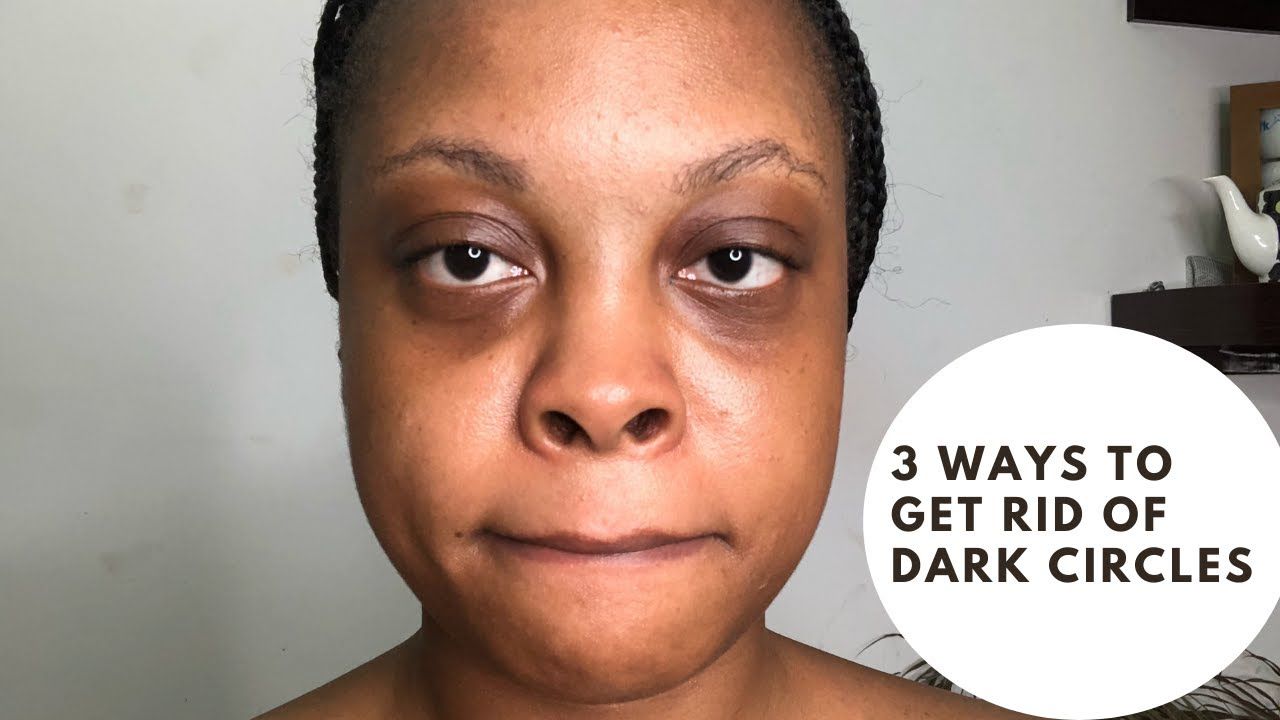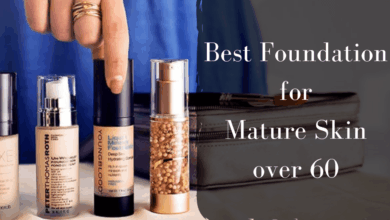
How to treat dark circles effectively and safely? This comprehensive guide dives deep into understanding the causes, from genetics and sleep deprivation to underlying medical conditions. We’ll explore a range of solutions, from simple home remedies to professional treatments, and even discuss lifestyle changes and dietary considerations. Get ready to uncover the secrets to banishing those unwanted dark circles and achieving radiant under-eye beauty.
Understanding the root causes of dark circles is crucial. Genetics, lack of sleep, and even allergies can play a significant role. We’ll examine the interplay of blood circulation, melanin production, and different types of dark circles, like periorbital hyperpigmentation and dark shadows. This in-depth look helps you tailor your treatment plan.
Underlying Causes of Dark Circles
Dark circles under the eyes, a common concern for many, can stem from a variety of factors, both superficial and deeply rooted. Understanding these underlying causes can help in developing targeted solutions and preventing future occurrences. Often, a combination of these factors contributes to the appearance of dark circles, making a comprehensive approach crucial for effective treatment.Beyond simple fatigue, a multitude of elements influence the development of these dark shadows.
These range from genetic predispositions to lifestyle choices, medical conditions, and even environmental factors. Identifying the root cause is often the first step towards finding a suitable treatment strategy.
Factors Contributing to Dark Circles
Various factors contribute to the development of dark circles. Genetics play a significant role, with some individuals predisposed to thinner skin under the eyes, making the underlying blood vessels more visible. Insufficient sleep disrupts the body’s natural restorative processes, leading to increased blood flow and swelling in the delicate eye area. Allergies, whether seasonal or persistent, can exacerbate inflammation and contribute to dark circles, along with inflammation caused by prolonged exposure to irritants.
Medical conditions, including certain blood disorders, can also influence the appearance of dark circles.
Role of Blood Circulation and Melanin Production
The intricate interplay of blood circulation and melanin production significantly influences the development of dark circles. Reduced blood circulation in the delicate skin around the eyes allows the blood vessels to be more visible, leading to a darkening effect. Melanin, the pigment responsible for skin tone, plays a part. An imbalance in melanin production can lead to localized darkening, especially in individuals predisposed to this condition.
Types of Dark Circles and Their Potential Causes
Different types of dark circles exist, each with potential causes. Periorbital hyperpigmentation, characterized by a brownish or grayish discoloration, can result from prolonged sun exposure, inflammation, or hormonal changes. Dark shadows, often appearing as a dull, grayish or bluish tone, can be linked to poor blood circulation, fluid retention, or a lack of sleep.
Comparison of Common Causes and Their Impact
| Cause | Impact on Appearance | Potential Symptoms |
|---|---|---|
| Genetics | Thinner skin under the eyes, increased visibility of blood vessels. | Dark circles present consistently, may be more prominent in certain individuals. |
| Lack of Sleep | Increased blood flow and swelling in the eye area, creating a darker appearance. | Puffiness, fatigue, and overall decreased well-being. |
| Allergies | Inflammation and swelling around the eyes, contributing to darkening. | Itching, redness, watery eyes, and general discomfort. |
| Sun Exposure | Increased melanin production in the affected area, potentially leading to hyperpigmentation. | Tanning, uneven skin tone, and darkening of the under-eye area. |
Medical Conditions Leading to Dark Circles
Certain medical conditions can contribute to the development of dark circles. These conditions can have a range of symptoms, and consulting a healthcare professional is crucial for accurate diagnosis and treatment.
| Condition | Possible Symptoms |
|---|---|
| Iron Deficiency Anemia | Fatigue, weakness, pale skin, and in some cases, dark circles. |
| Thyroid Problems | Weight changes, fatigue, dry skin, and in some cases, dark circles. |
| Blood Disorders | Bleeding tendencies, bruising, and potential for dark circles in some cases. |
| Nasal Allergies | Chronic runny nose, sneezing, itching, and in some cases, dark circles due to persistent inflammation. |
Home Remedies for Dark Circles
Tired of dark circles under your eyes? While some underlying medical conditions can contribute, many times these circles can be improved with simple home remedies. These remedies often work by improving blood circulation, reducing puffiness, and soothing the skin around the delicate eye area. Remember, consistent application is key to seeing results.Many people find that incorporating these home remedies into a daily routine, along with a healthy lifestyle, provides a significant improvement in the appearance of dark circles.
A holistic approach that combines proper sleep, hydration, and healthy habits, along with the remedies below, often yields the most satisfying results.
Effective Home Remedies
Home remedies for dark circles often involve ingredients that are readily available and generally safe for topical use. These natural approaches can provide a gentle and effective way to address the issue, particularly when used in conjunction with other healthy lifestyle choices.
- Cucumber Slices: Cucumber is well-known for its cooling and hydrating properties. The cool temperature of cucumber slices helps to constrict blood vessels, reducing puffiness and providing a soothing sensation. Applying chilled cucumber slices for 10-15 minutes can help reduce the appearance of dark circles and improve skin tone. This method is widely considered safe and effective for most skin types.
- Cold Compresses: Applying cold compresses, such as chilled tea bags or a dampened cloth, can have a similar effect as cucumber slices. The cold helps to constrict blood vessels, reducing inflammation and minimizing the appearance of dark circles. This method is a simple and readily accessible option for addressing dark circles, generally considered safe for most people.
- Aloe Vera Gel: Aloe vera gel, known for its soothing properties, can help to reduce inflammation and promote skin regeneration. Applying a thin layer of aloe vera gel to the under-eye area can help to minimize the appearance of dark circles and promote a healthy glow. Aloe vera is generally considered safe for topical use, though individuals with known allergies to aloe should avoid using it.
- Rosewater: Rosewater is known for its astringent properties, which can help to tone the skin and reduce puffiness. Applying rosewater with a cotton pad or by gently dabbing the area can help to refresh the under-eye area and minimize the appearance of dark circles. Rosewater is typically considered safe and well-tolerated by most skin types.
Comparing Home Remedies
| Remedy | Ingredients | Effectiveness | Potential Side Effects |
|---|---|---|---|
| Cucumber Slices | Cucumber | Generally effective in reducing puffiness and soothing the skin. | Minimal; possible slight irritation for sensitive skin. |
| Cold Compresses | Chilled water, tea bags, or dampened cloth | Effective in reducing puffiness and constricting blood vessels. | Minimal; possible slight discomfort for some. |
| Aloe Vera Gel | Aloe vera plant | Potentially effective in reducing inflammation and promoting skin regeneration. | Rare; possible allergic reaction for some individuals. |
| Rosewater | Rosewater | Potentially effective in toning the skin and reducing puffiness. | Minimal; possible slight irritation for sensitive skin. |
Ingredients to Avoid
Certain ingredients can irritate the delicate skin around the eyes, potentially worsening dark circles or causing other skin issues. It is essential to be mindful of what you apply to this sensitive area.
- Harsh Chemicals: Avoid products containing harsh chemicals, strong acids, or fragrances, as these can irritate the skin and worsen dark circles.
- Strong Scrubs or Exfoliants: Avoid using strong scrubs or exfoliants near the eye area, as these can cause irritation and damage the delicate skin.
- Products with Known Allergens: Be cautious of ingredients that are known to cause allergic reactions or sensitivities. Always patch test any new product before applying it to the entire under-eye area.
Over-the-Counter Treatments
Addressing dark circles isn’t solely about understanding the underlying causes and home remedies; effective over-the-counter treatments play a crucial role in achieving a brighter, more refreshed appearance. These products offer accessible solutions that can complement other approaches.Over-the-counter (OTC) products provide a convenient and often affordable way to target dark circles. They typically contain ingredients designed to address the underlying causes, such as improving blood circulation, reducing inflammation, or increasing hydration.
While OTC treatments can be beneficial, their effectiveness varies depending on the individual and the specific product. Consistency is key to seeing results.
Over-the-Counter Product Options
A range of OTC products is available, including eye creams, serums, and concealers. These products address various aspects of dark circles, from improving skin tone to reducing puffiness. Careful selection of the right product can significantly improve the appearance of the under-eye area.
Active Ingredients and Mechanisms of Action
Many OTC products contain specific active ingredients that target different aspects of dark circles. These ingredients work in various ways to lighten the appearance of dark circles.
Dealing with those pesky dark circles under your eyes can be a real drag, but there are ways to combat them! A healthy diet and plenty of sleep are crucial, but sometimes you just need a little extra help. You might be surprised to learn that a stylish tee like the conner ives protect the dolls t shirt can also boost your confidence, which can indirectly help you feel more refreshed and alert, potentially reducing the appearance of those dark circles.
Ultimately, consistent care and a positive mindset are key to achieving brighter, more radiant under-eye areas.
- Vitamin C: A powerful antioxidant, Vitamin C helps to reduce the appearance of dark spots and hyperpigmentation. It stimulates collagen production, contributing to firmer, healthier-looking skin.
- Hydroquinone: This ingredient is effective in lightening skin discoloration. However, it’s important to use it under medical supervision, as prolonged or improper use can lead to skin irritation or other side effects.
- Caffeine: Caffeine constricts blood vessels, reducing puffiness and promoting a more even skin tone. This effect can temporarily lessen the appearance of dark circles.
- Retinoids: These ingredients promote cell turnover, which can help to reduce the appearance of dark spots and fine lines. However, they can be irritating to sensitive skin, and it’s important to start with a low concentration.
- Hyaluronic Acid: A humectant, hyaluronic acid attracts and retains moisture, keeping the skin hydrated and plump. This can help to reduce the appearance of fine lines and wrinkles, which can contribute to the appearance of dark circles.
Comparison of Over-the-Counter Products
The effectiveness and cost of OTC treatments vary. A comparative table can assist in making informed choices.
| Product | Active Ingredients | Price Range | Effectiveness |
|---|---|---|---|
| Paula’s Choice 2% BHA Liquid Exfoliant | Salicylic Acid (2%) | $15-$25 | Effective for improving skin texture and reducing hyperpigmentation. Results may vary depending on the individual. |
| La Roche-Posay Toleriane Double Repair Face Moisturizer | Soothing ingredients | $20-$30 | Effective for moisturizing and reducing irritation, which can indirectly improve the appearance of dark circles. |
| Neutrogena Hydro Boost Water Gel | Hyaluronic Acid | $10-$15 | Effective for hydration, which can indirectly improve the appearance of dark circles. |
| Murad Rapid Relief Eye Treatment | Caffeine, Vitamin C | $30-$40 | Potentially effective for reducing puffiness and lightening dark circles. |
Importance of Following Product Instructions
Consistent and proper use of OTC products is crucial for optimal results. Carefully following the product instructions, including the recommended application frequency and usage guidelines, is essential to maximize effectiveness and minimize potential side effects. Overuse can lead to irritation or dryness, negating the benefits of the product.
Professional Treatments

Addressing dark circles with professional treatments often involves more intensive approaches than home remedies or over-the-counter products. These procedures can offer more significant and lasting results, but they typically come with a higher cost and potential risks. It’s crucial to consult with a dermatologist or a qualified medical professional to determine the most suitable treatment option for your specific needs and concerns.
Laser Therapy
Laser therapy uses precisely targeted beams of light to stimulate collagen production and reduce the appearance of dark circles. Different types of lasers are employed, each with its specific mechanism of action. Fractional lasers, for example, create microscopic wounds that trigger the body’s natural healing response, leading to improved skin texture and tone. Pulsed dye lasers can help reduce pigmentation and redness, which can contribute to the appearance of dark circles.The procedure involves applying the laser to the affected area, which might result in mild discomfort and a slight tingling sensation.
Cooling mechanisms are often employed to mitigate any discomfort. Multiple sessions are typically necessary to achieve optimal results, and the recovery time varies depending on the type of laser used and the individual’s response.
Micro-Needling
Micro-needling, also known as collagen induction therapy, utilizes tiny needles to create controlled micro-injuries in the skin. These tiny punctures stimulate collagen and elastin production, improving skin firmness and reducing the appearance of dark circles. The procedure involves applying a specialized device with tiny needles over the affected area, creating microscopic channels that encourage the body’s natural healing process.
Results are often gradual and may require multiple sessions.The procedure is generally well-tolerated, with some patients experiencing mild redness or swelling afterward. A topical numbing cream might be applied to enhance patient comfort. Recovery time is relatively short, usually a few days.
Chemical Peels
Chemical peels involve applying a chemical solution to the skin to remove the top layers of damaged skin cells. This process can improve skin texture and tone, reducing the appearance of dark circles. The strength and type of chemical used depend on the individual’s skin type and the desired outcome. Mild peels might be suitable for superficial discoloration, while stronger peels are used for deeper issues.During the procedure, a chemical solution is applied to the affected area, causing a controlled exfoliation of the skin.
After the treatment, the skin might experience mild redness, peeling, and dryness. Post-treatment care instructions are crucial for optimal healing and minimizing discomfort.
Comparison of Professional Treatments, How to treat dark circles
| Treatment | Pros | Cons | Potential Risks |
|---|---|---|---|
| Laser Therapy | Potentially significant results, targeted treatment | Multiple sessions required, higher cost, potential for mild discomfort | Skin irritation, infection, uneven skin tone, prolonged recovery in some cases |
| Micro-Needling | Stimulates collagen production, generally well-tolerated | Gradual results, multiple sessions required, potential for mild side effects | Infection, scarring, prolonged redness, uneven skin tone |
| Chemical Peels | Improved skin texture and tone, potentially effective for pigmentation | Potential for discomfort, varying recovery times, dependent on peel strength | Skin irritation, infection, scarring, hyperpigmentation |
Lifestyle Changes for Reducing Dark Circles
Dark circles under the eyes, a common aesthetic concern, can be influenced by a variety of factors. While genetics and underlying medical conditions play a role, lifestyle choices significantly impact their appearance. Adopting healthier habits can help reduce the visibility of dark circles and improve overall well-being. By prioritizing sleep, managing stress, and nourishing your body with a balanced diet and sufficient hydration, you can take proactive steps toward a brighter, more refreshed appearance.Beyond cosmetics, addressing dark circles through lifestyle adjustments promotes better overall health.
A holistic approach to self-care, incorporating healthy habits into daily routines, can yield positive results, leading to a more youthful and radiant complexion.
Prioritizing Sleep
Adequate sleep is crucial for the body’s natural repair processes. During sleep, the body replenishes tissues, including those around the eyes. Insufficient sleep can lead to the appearance of dark circles, as blood vessels under the skin become more prominent. Aim for 7-9 hours of quality sleep each night to support optimal cellular regeneration and reduce the visibility of dark circles.To incorporate this into your routine, establish a consistent sleep schedule.
Create a relaxing bedtime routine, such as taking a warm bath, reading a book, or practicing gentle stretches, to signal to your body it’s time to unwind. A dark, quiet, and cool bedroom environment can also contribute to a more restful sleep. Consider using blackout curtains or a sleep mask to block out light.
Managing Stress
Chronic stress can negatively impact the body, including the delicate skin around the eyes. Stress hormones can cause blood vessels to dilate, increasing blood flow to the area and potentially making dark circles more noticeable. Implementing stress-reducing techniques can be beneficial in minimizing the appearance of dark circles.Incorporate stress-reducing activities into your daily routine. Activities such as meditation, yoga, deep breathing exercises, or spending time in nature can help manage stress levels.
Taking regular breaks throughout the day, engaging in hobbies, and setting realistic expectations are also vital aspects of stress management.
Maintaining a Healthy Diet
A well-balanced diet rich in nutrients is essential for overall health and contributes to a healthy complexion. Nutrients like vitamins C and K, antioxidants, and essential fatty acids play a role in supporting healthy skin and reducing the appearance of dark circles.Consume a variety of fruits, vegetables, and whole grains to obtain a wide range of essential vitamins and minerals.
Incorporate foods rich in antioxidants, such as berries, leafy greens, and colorful vegetables. Include healthy fats from sources like avocados, nuts, and seeds to support skin health. Avoid processed foods, excessive sugar, and excessive caffeine, as these can contribute to inflammation and potentially worsen the appearance of dark circles.
Dealing with dark circles can be tricky, but a good skincare routine can really help. I’ve been trying some new eye creams lately, and honestly, they’ve made a noticeable difference. Speaking of noticeable, have you seen Lewis Hamilton’s amazing style on the red carpet? Lewis Hamilton’s best fashion moments on the red carpet are always inspiring.
Getting enough sleep and staying hydrated are also crucial for minimizing those dark circles. I’m definitely focusing on those two things to see if they improve my results.
Hydration
Adequate hydration is vital for maintaining healthy skin and reducing the appearance of dark circles. Dehydration can cause the skin to appear dull and dry, potentially making dark circles more noticeable. Drinking enough water throughout the day is essential for optimal skin health.Aim to drink at least eight glasses of water daily. Carry a water bottle with you and sip on water regularly throughout the day.
Include hydrating foods and beverages in your diet, such as fruits and vegetables high in water content, and herbal teas. Pay attention to your body’s thirst cues and drink water when you feel thirsty. This is crucial for maintaining proper hydration and reducing the appearance of dark circles.
Prevention Strategies
Dark circles, while often a natural part of aging or lifestyle factors, are definitely something we can actively mitigate. Preventive measures are key to maintaining a vibrant, healthy under-eye area. By incorporating these strategies into your daily routine, you can significantly reduce the likelihood of developing or worsening dark circles.Preventing dark circles is much like preventing wrinkles—it’s about proactive care rather than reactive solutions.
Consistent effort and a holistic approach to skincare are crucial in minimizing the appearance of dark circles over time.
Sun Protection
Sun exposure is a significant contributor to dark circles. Ultraviolet (UV) radiation can damage the delicate skin under the eyes, leading to increased pigmentation and blood vessel visibility. This, in turn, can result in a darker, more shadowed appearance.Protecting the delicate skin around your eyes is paramount. Consistent use of sunscreen is vital. The skin under your eyes is thinner and more sensitive, making it even more vulnerable to the damaging effects of the sun.
Dealing with dark circles can be tricky, but a good skincare routine can make a real difference. Plenty of sleep and a healthy diet are key, but for a more targeted approach, consider incorporating some brightening serums. Speaking of radiant looks, I was absolutely captivated by the stunning wedding of Zoe Chrissos and Colton Orr, Zoe Chrissos and Colton Orr’s wedding —their glow was undeniable! Maybe some of those tips they used for the big day can be applied to our skincare routines for a more youthful, brighter appearance?
Ultimately, consistent care is the best way to combat those dark circles and look our best.
Importance of Sunscreen
Using a broad-spectrum sunscreen with an SPF of 30 or higher is essential. This helps to filter out harmful UVA and UVB rays, preventing sun damage and promoting healthier skin. A high SPF is crucial for effectively protecting this vulnerable area.Applying sunscreen liberally, including the delicate skin around the eyes, is key. Think of it as a crucial layer of protection against the sun’s damaging effects.
Comprehensive Skincare Routine
A comprehensive skincare routine tailored to your skin type plays a pivotal role in preventing dark circles. A consistent routine, including cleansing, moisturizing, and gentle exfoliation, can help maintain the health and elasticity of the skin, reducing the appearance of dark circles.Implementing a proper skincare routine is like giving your skin a comprehensive check-up. It is not just about treating dark circles, but about promoting overall skin health.
- Cleansing: Gentle cleansing removes impurities and makeup, which can contribute to skin irritation and potential dark circles. A mild cleanser suited for the delicate eye area is essential.
- Moisturizing: Hydration is crucial for maintaining skin elasticity and firmness. A moisturizer formulated for the under-eye area will help keep the skin supple and healthy, which can help prevent the appearance of dark circles.
- Gentle Exfoliation: Regular, gentle exfoliation can help remove dead skin cells, promoting cell turnover and revealing brighter, healthier skin. Avoid harsh exfoliants that might irritate the delicate skin around the eyes.
Avoiding Excessive Rubbing
Frequent rubbing or harsh contact with the eye area can lead to irritation and inflammation, potentially worsening the appearance of dark circles. Gentle handling of the delicate skin is critical for maintaining its health and preventing unnecessary irritation.Avoid using harsh or abrasive products, or rubbing the eye area with your hands or other objects. Use gentle pressure and care when applying products or touching the area.
Dietary Considerations for Dark Circles
Dark circles, those unsightly shadows under your eyes, can often be influenced by your daily diet. The nutrients you consume play a crucial role in the overall health of your skin, including the delicate skin around your eyes. Proper nutrition supports collagen production, blood circulation, and overall skin tone, all of which can contribute to reducing the appearance of dark circles.A balanced diet rich in specific nutrients can significantly impact the health of your skin, directly affecting the area under your eyes.
By focusing on foods that contain vitamin C, antioxidants, and iron, you can potentially improve the appearance of dark circles.
Vitamin C for Collagen Production
Vitamin C is a vital nutrient for collagen production. Collagen is a structural protein that provides strength and elasticity to the skin. Adequate collagen helps maintain the skin’s firmness and resilience, which can contribute to reducing the appearance of dark circles. When collagen levels are diminished, the delicate skin beneath the eyes becomes more prone to showing the blood vessels underneath.
Antioxidants to Combat Free Radical Damage
Antioxidants protect the skin from free radical damage. Free radicals are unstable molecules that can cause oxidative stress, leading to premature aging and inflammation, including the skin around the eyes. Consuming foods rich in antioxidants can help neutralize these free radicals, promoting healthy skin and potentially reducing the appearance of dark circles.
Iron for Improved Blood Circulation
Iron plays a critical role in transporting oxygen throughout the body, including to the skin. Poor blood circulation can contribute to the appearance of dark circles, as reduced blood flow can result in a duller, darker complexion under the eyes. Iron-rich foods can help improve blood circulation, potentially brightening the area under the eyes.
Importance of a Balanced Diet
A balanced diet, encompassing a wide variety of foods, is essential for overall health. It provides the necessary vitamins, minerals, and antioxidants for optimal skin health and reduces the appearance of dark circles. This means consuming a variety of fruits, vegetables, lean proteins, and whole grains. A diet lacking in essential nutrients can negatively affect the skin’s ability to repair and rejuvenate, potentially worsening the appearance of dark circles.
Foods Rich in Vitamin C
A healthy diet rich in vitamin C is crucial. Citrus fruits like oranges, lemons, and grapefruits are excellent sources of vitamin C. Other good sources include berries, kiwi, and bell peppers.
Foods Rich in Antioxidants
Antioxidants are essential for protecting your skin from free radical damage. Colorful fruits and vegetables are packed with antioxidants. Berries, dark leafy greens, and cruciferous vegetables are particularly beneficial. Dark chocolate and nuts are also good sources.
Foods Rich in Iron
Iron is vital for blood circulation. Red meat, poultry, fish, beans, lentils, and spinach are good sources of iron. Combining iron-rich foods with vitamin C-rich foods can enhance iron absorption. For example, eating spinach with a side of orange slices can maximize iron absorption.
Identifying Misconceptions and Myths

Dark circles under the eyes can be frustrating and often lead to people trying various remedies. Unfortunately, many of these remedies are based on misconceptions and myths, making it challenging to pinpoint the true causes and effective solutions. This section will debunk common myths and highlight the accurate information to help you make informed decisions about treating your dark circles.
Common Misconceptions About Dark Circles
Many beliefs about dark circles are not supported by scientific evidence. These misconceptions can lead to wasted time and money on ineffective treatments, and even potentially harmful practices. It’s crucial to distinguish between fact and fiction to ensure you’re using the right strategies.
Debunking the Myths
A common misconception is that dark circles are solely due to lack of sleep. While insufficient sleep can contribute to the appearance of dark circles, it’s not the sole culprit. Other factors, including genetics, underlying health conditions, and lifestyle choices, play a significant role. Similarly, applying heavy makeup or specific products directly under the eyes is not a long-term solution.
These products might cause irritation and further exacerbate the problem. Another widespread myth is that dark circles can be treated overnight. Visible results usually take time and consistent effort, whether with home remedies, over-the-counter products, or professional treatments.
Comparing Misconceptions and Correct Information
| Misconception | Correct Information |
|---|---|
| Dark circles are solely caused by lack of sleep. | Lack of sleep can contribute to the appearance of dark circles, but other factors, such as genetics, underlying health conditions, and lifestyle choices, also play a significant role. |
| Applying heavy makeup or specific products directly under the eyes will eliminate dark circles. | Applying heavy makeup or products directly under the eyes can potentially cause irritation and further exacerbate the problem. A proper skincare routine and appropriate products are crucial. |
| Dark circles can be treated overnight. | Visible results from dark circle treatments, whether with home remedies, over-the-counter products, or professional treatments, usually take time and consistent effort. |
| Dark circles are a sign of aging and cannot be improved. | While age can influence the appearance of dark circles, they can often be improved with various treatments and lifestyle adjustments. Early intervention is key. |
Outcome Summary: How To Treat Dark Circles
From natural remedies to advanced procedures, we’ve covered a spectrum of options for treating dark circles. We explored the science behind these solutions, the importance of lifestyle adjustments, and the potential risks associated with different approaches. Remember, a personalized approach, understanding your unique needs, is key to effectively addressing dark circles. By incorporating the insights shared here, you’ll be well-equipped to choose the best path towards brighter, more refreshed eyes.




